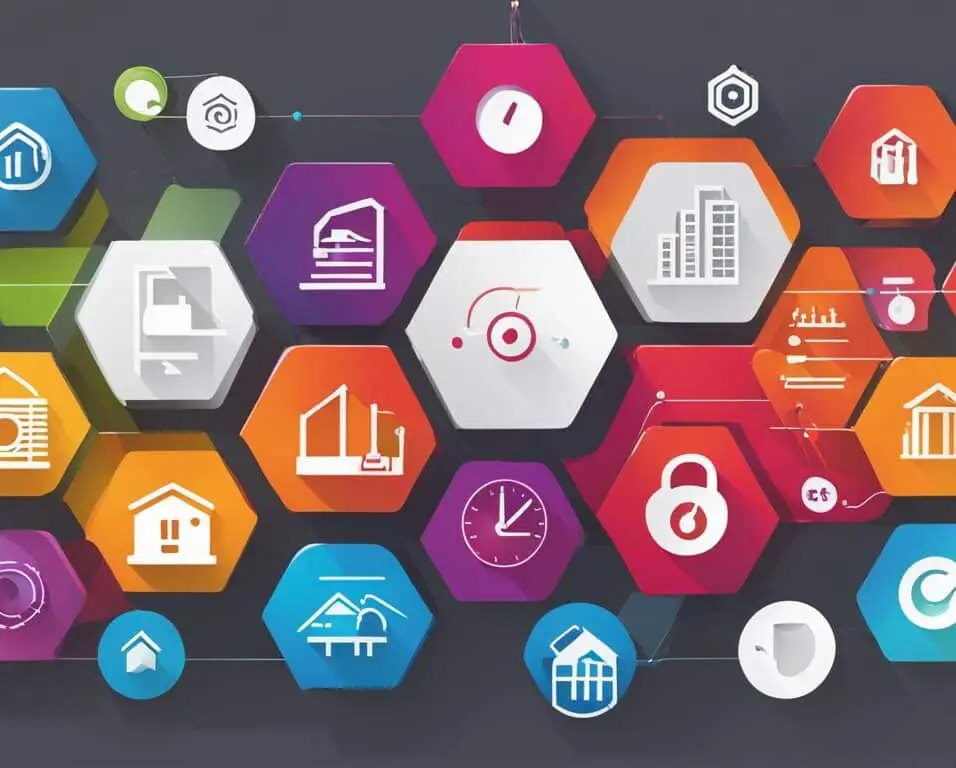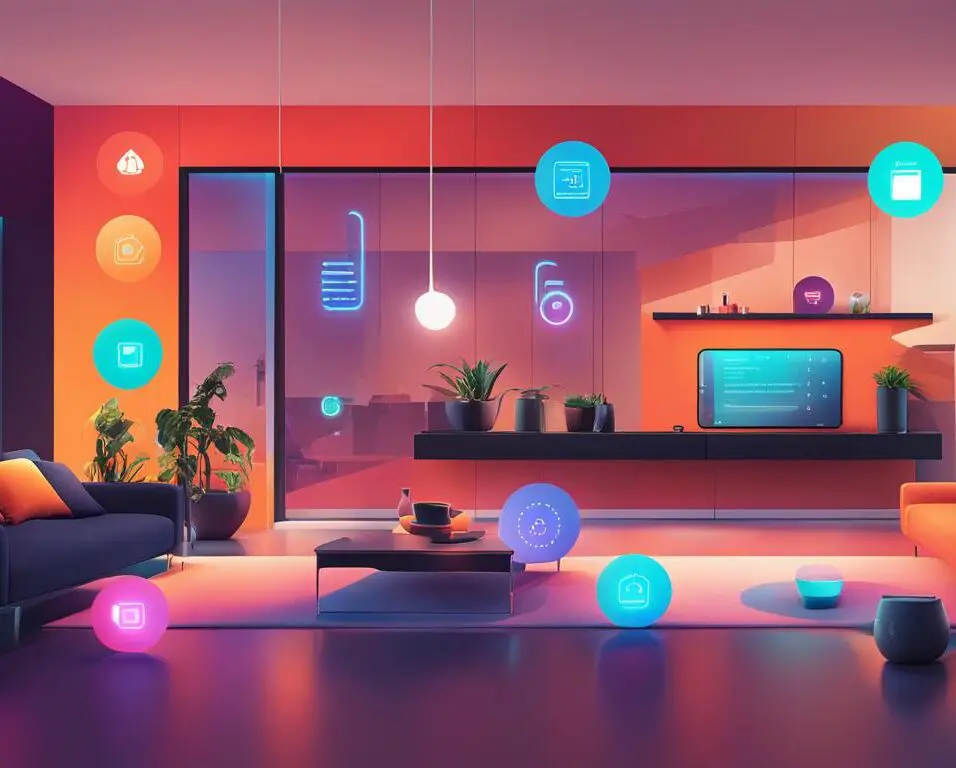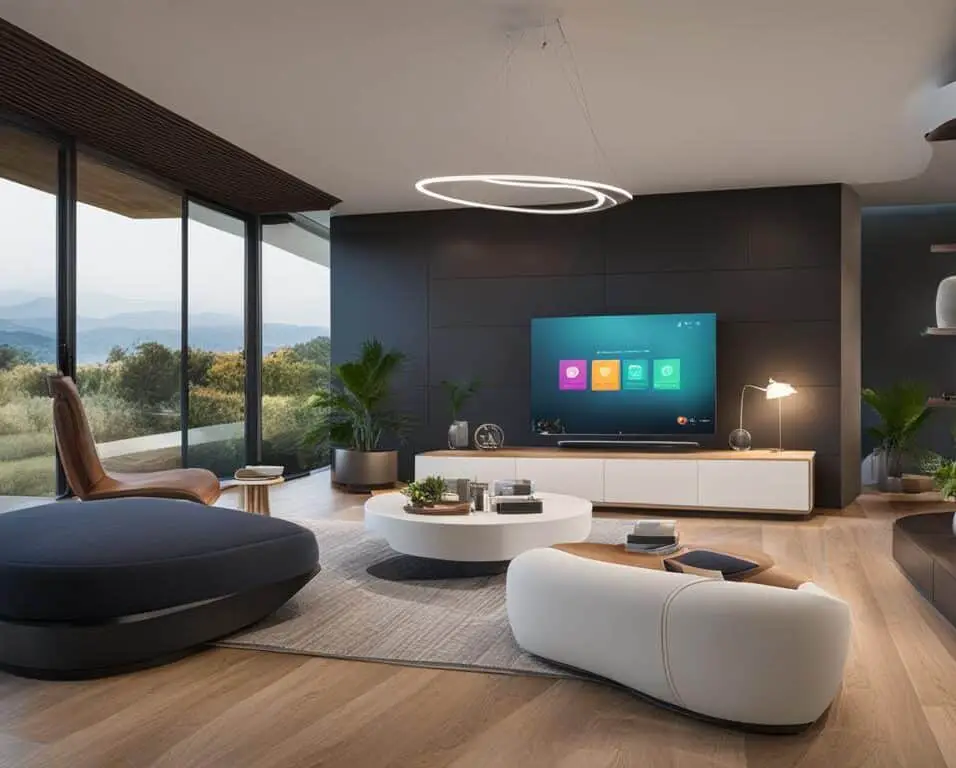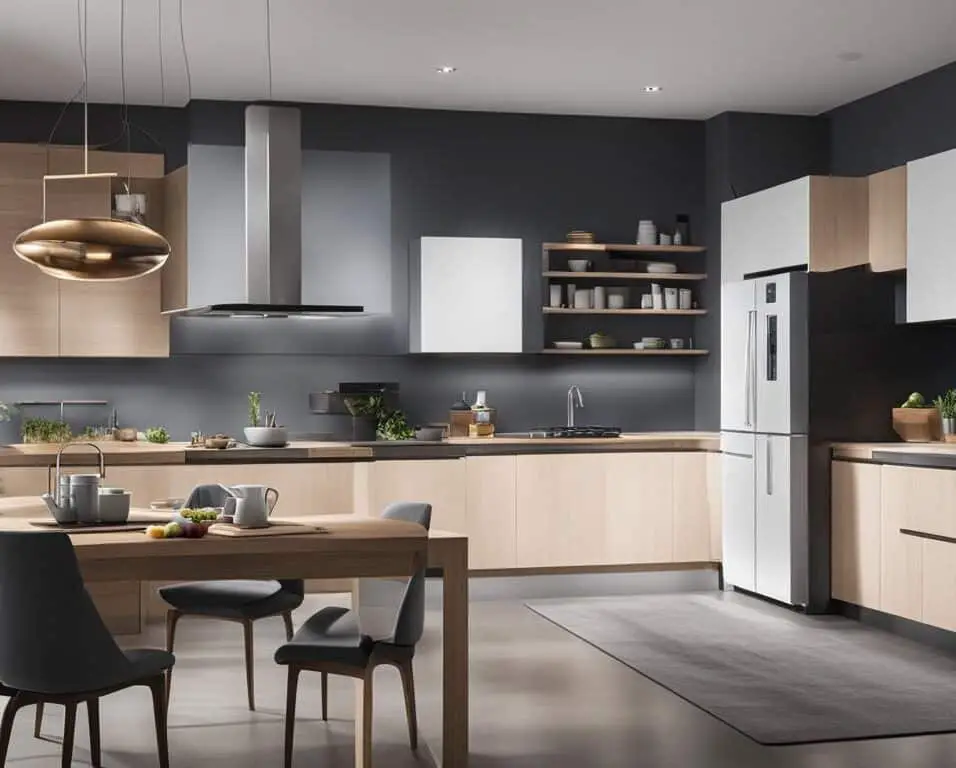Integrating IoT Devices for Efficient Smart Home Solutions
The Internet of Things (IoT) has revolutionized the concept of smart homes, creating a seamless network of interconnected devices that enhance convenience, energy efficiency, and security. By integrating IoT devices into our homes, we can experience a new level of efficiency and control over our living spaces. From automated routines to personalized settings, smart home solutions powered by IoT technology are reshaping the way we live.
Key Takeaways:
- Integration of IoT devices in smart homes offers enhanced convenience, energy efficiency, and security.
- Smart home solutions powered by IoT technology transform the way we live and interact with our living spaces.
- Automated routines and personalized settings are made possible through IoT integration, providing a new level of control.
- The seamless network of interconnected devices in smart homes contributes to more efficient and sustainable living.
- While there are challenges to navigate, the continuous development and standardization of IoT technologies pave the way for a bright future of smart homes.
The Rise of Smart Homes: A Glimpse into the Future
The concept of smart homes has evolved from science fiction to reality, thanks to the integration of IoT devices. With a complex network of connected appliances and gadgets, smart homes offer enhanced convenience and control, transforming the way we interact with our living spaces.
In the future, smart homes will become even more pervasive, seamlessly integrating with our daily lives. The advancements in technology will enable homeowners to experience a new level of comfort, efficiency, and personalized living.
Intelligent Automation and Personalized Experiences
Smart homes of the future will feature advanced automation capabilities, opening up a world of possibilities. Homeowners will be able to control every aspect of their living environment with just a few taps on their smartphones. From adjusting lighting and temperature settings to customizing home entertainment systems, the future of smart homes will revolve around personalized experiences.
Imagine walking into your home after a long day at work, and the lights automatically dim, your favorite music starts playing, and the temperature adjusts to your preferred level of comfort. With smart homes, these personalized experiences will become a reality, creating a truly welcoming and tailored atmosphere.
Seamless Integration and Interconnectivity
The future of smart homes will involve the seamless integration and interconnectivity of various IoT devices. Homeowners will have access to a centralized control system that manages and coordinates all connected devices, creating a harmonious ecosystem within their homes.
Whether it’s syncing your smart refrigerator with your grocery list app or having your smart security system communicate with your wearable device, the future smart home will prioritize ease of use and communication between devices. This seamless integration will optimize efficiency and convenience, making everyday tasks simpler and more intuitive.
Enhanced Energy Efficiency and Sustainability
Smart homes of the future will take energy efficiency and sustainability to new heights. IoT devices will enable homeowners to monitor and manage energy consumption in real-time, optimizing usage and reducing waste.
For example, smart thermostats will learn your preferences and automatically adjust temperature settings to maximize energy efficiency. Smart lighting systems will detect when a room is unoccupied and turn off lights to conserve energy. These innovations will not only lower electricity bills but also contribute to a greener, more sustainable future.
Enhanced Security and Safety Measures
Security will be a top priority in the future of smart homes. IoT devices will provide robust security measures to protect homes from potential threats.
Smart surveillance cameras will use advanced algorithms to detect and alert homeowners of any suspicious activities. Biometric authentication systems will ensure only authorized individuals can access the home, enhancing overall safety. The integration of AI will enable smart homes to learn patterns and detect anomalies, providing an extra layer of security and peace of mind.
| Benefits of Future Smart Homes | Explanation |
|---|---|
| Convenience | Smart homes will offer unparalleled convenience, allowing homeowners to control and manage their living spaces effortlessly. |
| Energy Efficiency | The integration of IoT devices will optimize energy usage, reducing waste and promoting sustainability. |
| Personalization | Future smart homes will provide personalized experiences, adapting to individual preferences and creating a tailored living environment. |
| Security | Robust security measures will safeguard smart homes, protecting homeowners and their possessions from potential threats. |
The future of smart homes holds immense potential to revolutionize the way we live. As technology advances and IoT devices continue to evolve, the integration of smart home solutions will become increasingly common, enhancing our everyday lives in ways we never thought possible.
IoT-Driven Convenience: Enhancing Everyday Life
IoT-driven convenience revolutionizes the way we manage our daily lives, offering a seamless integration of technology that brings ease and efficiency to our routines. By automating various aspects of our home, IoT devices enhance convenience, making everyday tasks more effortless and enjoyable.
One of the key advantages of IoT-driven convenience is the ability to program home appliances to respond to our preferences. Imagine waking up to the aroma of freshly brewed coffee, as your coffee machine automatically starts brewing based on your morning routine. With IoT-enabled appliances, such as smart refrigerators and washing machines, we can create personalized settings and schedules to suit our needs, ultimately saving time and effort.
Another significant aspect of IoT-driven convenience is the ability to control and monitor our devices remotely via smartphone apps. Whether it’s adjusting the thermostat temperature before arriving home, turning off lights that were accidentally left on, or even receiving notifications when someone is at our front door, IoT technology puts us in control of our surroundings regardless of our physical location.
Seamless Integration and User Experience
One of the remarkable aspects of IoT-driven convenience is its seamless integration of various devices and platforms. With interoperability being a key focus in the development of IoT technology, multiple smart devices can work together, sharing data and capabilities to create a unified user experience. This means that controlling multiple devices, such as lighting, heating, and security systems, can be done through a single interface or voice command, simplifying the user experience.
Moreover, IoT-driven convenience extends beyond individual devices, as it can integrate with other smart systems in our homes. For example, connecting our smart appliances with a virtual assistant platform, such as Amazon Alexa or Google Assistant, allows for voice-controlled interactions and streamlined automation. By harnessing the power of IoT, home automation becomes more intuitive and effortless, elevating our living experience to new heights.

“IoT-driven convenience streamlines daily activities and adds a new level of ease and control to our routines.”
Ultimately, IoT-driven convenience empowers homeowners to lead more productive and efficient lives. By automating repetitive tasks, optimizing energy usage, and providing remote control capabilities, smart home automation enhances convenience, comfort, and peace of mind. As the IoT ecosystem continues to evolve, we can expect even more innovative solutions that further improve our everyday lives.
Energy Efficiency and Sustainability: A Win-Win for Homeowners and the Planet
The integration of IoT in smart homes goes beyond convenience. It contributes to energy efficiency and sustainability by optimizing energy usage. Smart thermostats, such as the popular brands Nest and Ecobee, utilize advanced sensors and algorithms to learn the temperature preferences of homeowners. This enables them to automatically adjust the temperature settings, ensuring optimal comfort while minimizing energy waste. With the ability to detect occupancy, smart thermostats can also adjust settings when no one is at home, further reducing energy consumption. In fact, studies have shown that smart thermostats can save homeowners up to 20% on heating and cooling costs, making them an intelligent investment for both the environment and our wallets.
Smart lighting systems, such as Philips Hue and Lutron, also play a significant role in energy efficiency. These systems utilize LED technology, which is more energy-efficient than traditional incandescent bulbs. In addition, they offer advanced features like motion sensors and scheduling capabilities. Smart lighting systems can automatically turn off lights when a room is empty, reducing unnecessary energy usage. Furthermore, homeowners can control their lighting remotely through smartphone apps or voice commands, ensuring lights are never left on when not needed. By embracing smart lighting, homeowners can significantly decrease energy waste and contribute to a greener living environment.
The benefits of energy-efficient IoT devices extend beyond individual households. The collective impact of widespread adoption of smart thermostats and lighting systems can help reduce the overall energy demand and greenhouse gas emissions. This, in turn, contributes to building a more sustainable future and mitigating the effects of climate change. By empowering homeowners with the ability to optimize their energy consumption, IoT-enabled smart homes are at the forefront of promoting environmental responsibility.
The Benefits of Energy Efficiency in Smart Homes:
- Reduced energy waste
- Lower electricity costs
- Enhanced comfort and convenience
- Environmental sustainability
| Smart Devices | Key Features |
|---|---|
| Smart Thermostats (e.g., Nest, Ecobee) |
|
| Smart Lighting Systems (e.g., Philips Hue, Lutron) |
|
Security Reinvented: Safeguarding Your Home with IoT
IoT devices play a crucial role in enhancing home security. By integrating smart cameras, motion detectors, and doorbell cameras into your smart home system, you can have real-time monitoring and notifications that allow you to keep an eye on your property from anywhere.
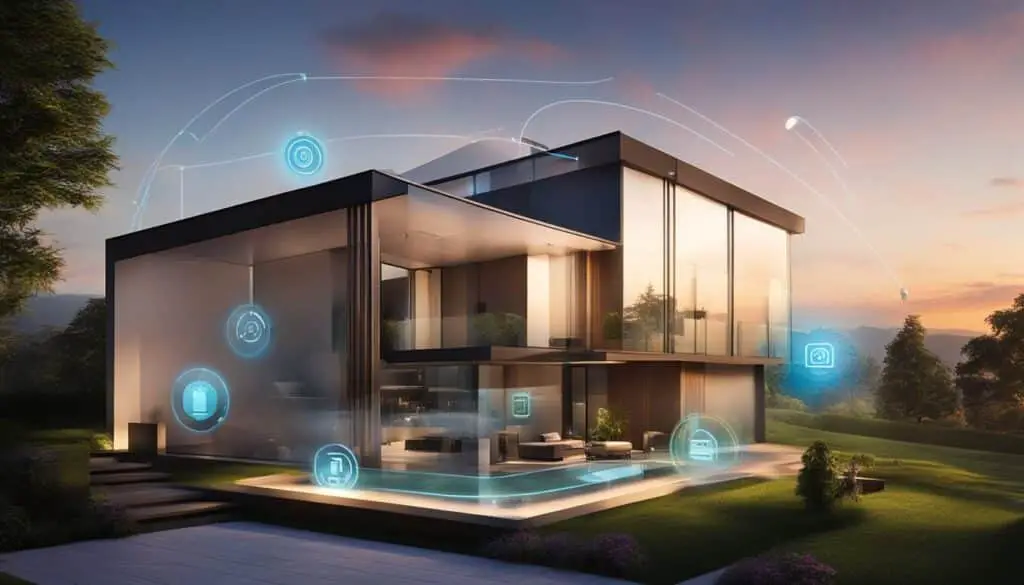
These IoT devices provide an extra layer of protection, giving homeowners peace of mind and deterring potential intruders. With high-definition video and advanced motion detection capabilities, smart cameras can capture suspicious activities and send alerts to your smartphone in real-time.
The integration of artificial intelligence further enhances the security features of IoT devices. By using intelligent algorithms and machine learning, these devices can distinguish between normal activities and potential threats, reducing false alarms and improving overall security.
“With the advancement of IoT technology, securing our homes has become smarter and more convenient than ever before. These intelligent devices provide real-time surveillance and intelligent threat detection, empowering homeowners with greater control and peace of mind.” – Home Security Expert
Smart home security systems can be seamlessly integrated with other IoT devices, such as smart door locks and alarms, creating a comprehensive security solution that can be easily controlled and monitored from a centralized app.
Whether you are at work or on vacation, you can receive instant notifications and access live video feeds to ensure the safety of your home and loved ones. In case of any suspicious activity, you can take immediate action or notify the authorities if necessary.
Innovative Features for Enhanced Security:
- High-definition video surveillance
- Real-time alerts and notifications
- Intelligent motion detection
- Remote access and control
- Integration with smart locks and alarms
With the continuous advancement of IoT security technology, smart homes are becoming more secure and sophisticated. By harnessing the power of IoT, homeowners can create a connected and protected living environment that offers peace of mind and convenience.
Challenges and Considerations: Navigating the IoT Landscape
As IoT technology becomes more prevalent in smart homes, it brings forth a host of challenges and considerations that must be carefully addressed. Two significant areas of concern are data security and privacy, requiring manufacturers and developers to prioritize robust security measures to safeguard user information. Furthermore, ensuring compatibility and seamless communication between different IoT devices poses another obstacle in creating a cohesive smart home ecosystem. Alongside these challenges, the evolution of IoT necessitates a proactive approach to address privacy concerns and establish ethical data practices.
Protecting User Data
With the rapid proliferation of IoT devices, protecting user data has become paramount. Robust security measures, such as encryption and authentication protocols, must be implemented to prevent data breaches and unauthorized access. Manufacturers and developers should adopt industry best practices and stay updated with the latest cybersecurity advancements to mitigate vulnerabilities.
Ensuring Device Compatibility
One of the challenges in the IoT landscape is ensuring the seamless integration and compatibility of different devices. The diverse range of manufacturers and protocols can create interoperability issues. Standardization efforts are essential to streamline communication among IoT devices, allowing them to work together harmoniously and maximize the benefits of a smart home ecosystem.
Addressing Privacy Concerns
As IoT devices collect vast amounts of data, privacy concerns arise regarding the use, storage, and sharing of this information. Transparent data practices that empower users with control over their personal data are crucial for fostering trust. Additionally, regulatory frameworks must evolve to protect individuals’ privacy rights and govern the responsible use of IoT data.
Ethical Data Practices
As data collection becomes intrinsic to IoT devices, ethical considerations should guide their implementation. Adhering to ethical data practices involves ensuring consent-based data collection, anonymization of personal data, and establishing clear guidelines for data usage. Creating a culture of responsible data handling fosters user confidence in IoT technology.
“The seamless integration of IoT devices in smart homes offers unparalleled convenience, but the challenges must not be overlooked. By prioritizing data security, compatibility, privacy, and ethical data practices, we can navigate the IoT landscape effectively and build smart homes that are both efficient and secure.”
Conclusion: A Bright Future Ahead
The integration of IoT devices in smart homes has revolutionized the way we live and interact with our living spaces. With the limitless potential of IoT, the future holds even more exciting advancements that will enhance our lives in unimaginable ways. Smart home technology is constantly evolving to provide us with ever-increasing convenience, efficiency, security, and sustainability.
However, it is important to acknowledge that challenges exist in the IoT landscape. Privacy and security concerns have become significant considerations, given the vast amount of data collected by smart connected devices. This calls for continuous development and standardization of IoT technologies to prioritize strong security measures and ensure the ethical use of data.
Despite these challenges, the future of IoT is promising. Advancements in smart home technology will enable us to have even more control over our living spaces, making our homes more efficient, secure, and sustainable. With ongoing research and innovation, we can expect to see further integration of IoT devices, seamless connectivity, and enhanced user experiences that truly transform the way we live.
FAQ
What is IoT?
IoT stands for the Internet of Things. It refers to the network of interconnected devices that communicate with each other and the internet, enabling enhanced functionality and automation.
How does IoT benefit smart homes?
IoT devices in smart homes provide convenience, energy efficiency, and security. They allow homeowners to automate tasks, control devices remotely, optimize energy usage, and monitor their homes in real-time.
What are some examples of IoT devices in smart homes?
Examples of IoT devices in smart homes include smart thermostats, smart lighting systems, smart cameras, motion detectors, and doorbell cameras.
How does IoT improve energy efficiency in smart homes?
IoT devices like smart thermostats and lighting systems optimize energy usage by adjusting settings based on user preferences and automatically turning off when rooms are empty. This reduces energy waste and lowers electricity costs.
How do IoT devices contribute to home security?
IoT devices such as smart cameras, motion detectors, and doorbell cameras enhance home security by providing real-time monitoring and notifications. They enable homeowners to remotely monitor their property and detect any potential threats.
What are the challenges associated with IoT in smart homes?
Some challenges include data security and privacy concerns, compatibility between different IoT devices, and addressing ethical data practices. However, manufacturers and developers are continuously working to address these challenges and improve the IoT landscape.
What does the future hold for IoT and smart homes?
The future looks promising for IoT and smart homes, with continued advancements in technology, improving convenience, efficiency, and security. The integration of IoT is expected to revolutionize the way we live and interact with our living spaces.




